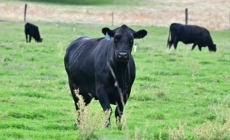-
3 Dogs Left Alone in Living Room—Owner Films What She Comes Home To - 17 mins ago
-
Volkswagen, Hit by Tariffs, Reports $1.5 Billion Loss and Warns of Chip Shortage - 20 mins ago
-
Southern California teacher arrested on suspicion of sexually abusing multiple children, officials say - 32 mins ago
-
Half of Americans Don’t Know This Common Habit Increases Cancer Risk - 52 mins ago
-
From Gaza to New York’s Mayoral Race, Jewish Identity Splits Over Israel’s Future - about 1 hour ago
-
Can $750 a month help people exit homelessness? - about 1 hour ago
-
Republican Rebellion Over Trump’s Argentina Beef Imports Grows - about 1 hour ago
-
Wilders’s Far-Right Party Faces Rebuke in the Netherlands - 2 hours ago
-
What makes a rebellion? Trump troop deployment may hinge on definition - 2 hours ago
-
Jenson Button Confirms Reason For Racing Retirement Ahead Of WEC Finale - 2 hours ago
Recreational salmon fishing is resuming this weekend in California
After a two-year shutdown, fishing boats will fan out along the California coast angling for Chinook salmon this weekend as recreational fishing resumes under strict limits.
Coastal salmon fishing was banned in 2023 and 2024 in an effort to help the population recover after years of declines. While commercial fishing remains canceled for a third consecutive year, fishery regulators recently decided to allow a limited season for recreational fishing on certain dates and with strict quotas.
“We’re all very excited,” said William “Captain Smitty” Smith, who was readying his charter fishing boat Riptide at Pillar Point Harbor in Half Moon Bay. “There’s a lot of buzz all around the harbor with everybody getting ready for it.”
Smith and his two deckhands have been buying bait and preparing hooks, nets and other gear to take 18 passengers fishing Saturday and Sunday. He said within hours of the April announcement that limited fishing would be allowed, “my regulars all called and basically filled the boat.”
Smith is 71 and has been in the charter boat business for 50 years. The last time he was able to take passengers fishing for salmon was in 2022.
As his business has struggled during the last two years, he has turned to other types of outings to make ends meet, including fishing for rockfish, leading whale-watching trips and holding burials at sea where mourners scatter the ashes of loved ones.
He said anglers are “chomping at the bit to go.” Each person will be allowed to catch up to two fish per day.
The California Department of Fish and Wildlife is limiting ocean fishing under quotas in two windows in the summer and fall. The first is set to open Saturday-Sunday and allow for up to 7,000 salmon to be caught statewide.
If that number of fish isn’t reached during the opening weekend, salmon fishing will be allowed until the limit is reached in subsequent stretches, which may include July 5-6, July 31-Aug. 3, and Aug. 25-31.

Fishing boats leave Santa Cruz Harbor on Tuesday, April 15, 2025 in Santa Cruz.
(Nic Coury/For The Times)
In addition to Half Moon Bay, fishing boats are expected to head out this weekend from other harbors in Central and Northern California such as Morro Bay, Santa Cruz, San Francisco, Bodega Bay and Fort Bragg.
“Given the 2-year ocean salmon fishery closure and the short duration of this fishing period, angler participation is expected to be high,” the department said in its announcement. “Anglers should prepare for crowds and long wait times at public launch ramps and marinas and consider travel, parking, and launch ramp conditions when finalizing plans.”
The agency said fishing will reopen in the fall in some regions — including from Point Reyes in Marin County south to near Half Moon Bay, and from there to Point Sur in Big Sur — under a separate harvest limit guideline of 7,500 Chinook salmon.
The fishing industry depends on fall-run Chinook, which migrate upstream to spawn from July through December. For decades, government-run hatcheries in the Central Valley have reared and released millions of salmon each year to help boost their numbers.
Other salmon runs have suffered more severe declines. Spring-run Chinook are listed as threatened under the Endangered Species Act, and winter-run Chinook are endangered.
Biologists say salmon populations have declined because of a combination of factors including dams, which have blocked off spawning areas, the loss of vital floodplain habitats, and global warming, which is intensifying droughts and causing warmer temperatures in rivers.
During the severe 2020-22 drought, the water flowing from dams sometimes got so warm that it was lethal for salmon eggs. Although that drought was a major factor behind the declines in the salmon population, those who work in fishing also blame California’s water managers and policies, saying too much water has been pumped to farms and cities, depriving rivers of sufficient cold water at the times salmon need it.
Smith said he hopes to see “responsible water management” where state officials prioritize river flows for fish, as well as efforts to restore floodplains and improve hatchery operations.
Because salmon typically feed in the ocean for about three years and then return to their natal streams, the decline in the numbers of surviving juvenile fish during the drought left a reduced population of adult fish. Scientists expect the population should improve somewhat next year because of the boost they received during 2023’s historic wet winter, though they also caution that the situation facing California’s salmon remains dire.
Smith said one change that has nurtured his hopes came last year, when the last of four dams were dismantled on the Klamath River in Northern California, enabling salmon to reach upstream spawning areas that had been sealed off for more than a century.
“I’m very hopeful for our future,” he said, adding that he is thinking about his 13-year-old grandson and the next generation.
“I want there to be a fishery for my grandson. I want him to be able to experience the thrill of catching a fish in the ocean.”
Source link

















